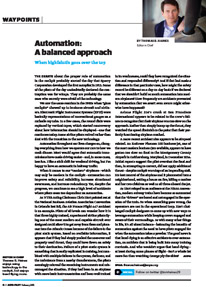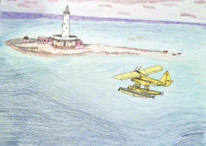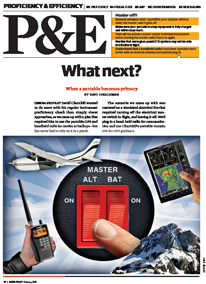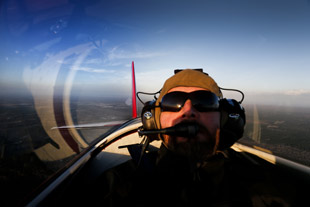Readers agreed with Editor in Chief Tom Haines, who wrote in his “Waypoints” column that while technology is exciting, hand-flying is more fun.

Tom Haines said a lot in a one-page article. I was a Navy carrier pilot for 31 years; I flew mostly fighters. We were single-seat, one comm radio, and a military VOR (tacan).
I was flying as co-pilot in a C–12 that had a system that was very sophisticated for its time. Taking off at Andrews Air Force Base, flying to Norfolk, Virginia, I forgot to initialize the flight plan. It was CAVU to the moon, and the first leg was to a vortac about 20 miles away. The pilot almost panicked. I said, Hey, all we gotta do is tune in the tacan. That guy was the personification of the sentence Haines had in his article—something went wrong and he was totally out of the operational loop.
Now, as I fly my Mooney with a GPS and I am cleared direct on a 500-mile leg, I have to keep reminding myself to tune the VORs and keep cognizant of what is going on. Electronics and mechanical devices are great but you still have to fly the darn airplane.
Chuck Long
AOPA 0905465
Chesapeake, Virginia
I had been flying my Cub a lot since I was between students and really love flying tailwheel aircraft—simple window-open, stick-and-rudder fun. So I hadn’t had a student in our Cirrus SR22 in a while and when I went up for a quick flight, I felt more at home than when flying it regularly. The CFI in the left seat was acting like he was the hapless new student trying to kill me as I failed systems and had to stay on top of both him and the airplane. We had a good time and both picked up our game a bit.
The act of being fully engaged in physically flying the Cub had kept me prepared for the more complex aircraft by minimizing the bandwidth needed for the basic flying tasks, allowing more attention to be given to the automation and actions of the student.
Gregg Beaty
AOPA 5561015
San Diego, California
“The problem is not so much dependence on the automation as it is allowing one’s preoccupation to distract from the primary task of flying the airplane. Being head down trying to figure out why the autopilot didn’t do what the pilot thought is the last thing to do when the airplane is headed off on an unintended flight path.”
Dennis Wolf
AOPA 418690
Great Neck, New York
Splash!
I just read with trepidation my father’s February column describing the engine failure that nearly orphaned me at the age of five (“Proficient Pilot”). Dad later taught me to fly, so I could not help but wonder what I would be doing today, and how different my life would be, had his accident been fatal. Being prepared for an engine failure at any time is a philosophy he taught me as a student and that I relay to my students. I too have been criticized for over-emphasizing this possibility, and this criticism has caused me at times to question my teaching technique. Your column affirmed my feelings about this subject, making an indelible impression. Thank you for being ready for that engine failure and thank you for writing this piece. Never stop sharing. You never know how significant one small story can be to somebody—especially me.
Brian Schiff
AOPA 830048
Moorpark, California

Great Escapes
I really enjoyed Dave Hirschman’s “Fresh Catch: Bahamas Fishing Adventure.” So much so, in fact, that I decided to draw a picture of the Bird Rock lighthouse. I thought you might like it. Would you tell Chris Rose he did a fantastic job with the photographs?
Crystal Pitts
AOPA 6171008
Bismarck, Arkansas
What next?
I just read Dave Hirschman’s “Technique: What Next?” with immense interest. I was taking an instrument lesson and experienced, almost to the letter, the scenario described in his article. We were in IFR conditions, 500-foot ceilings, electrical failure, and things going south quickly. We were able to declare an emergency prior to losing all the radios. Thanks to an outstanding CFI and redundancy, a Garmin 696, Foreflight, and a Dynon, it simply turned out to be an excellent lesson—hopefully, one I don’t repeat again.
Ken Richardson
AOPA 7280415
Springfield, Missouri
 “I was flying to San Marcos, Texas, IFR. While over Houston I lost the altimeter followed by the battery. But I had my portable radio and iPad with WingX. I was able to communicate and navigate and fly without incident. Landed safely and repaired and continued on.”
“I was flying to San Marcos, Texas, IFR. While over Houston I lost the altimeter followed by the battery. But I had my portable radio and iPad with WingX. I was able to communicate and navigate and fly without incident. Landed safely and repaired and continued on.”
Ronald Taglieri
AOPA 856372
Pass Christian, Mississippi
Diesel 172
You may not be aware of it, but two Thielert-powered 172s have soldiered on in your backyard for years (“Little Diesel=Big Fuel Savings”). I operated traffic-watch airplanes in the Washington, D.C., area for 14 years with a bunch of 172s, and converted two of them in 2006. Once we figured them out (and trust me, there is a learning curve) we had good service out of them.
I got 2,600-plus hours out of one of the first 1.7L engines I had, in spite of their reputation. That one has since been replaced with another 1.7L. The other airplane has a 2.0L with roughly 2,200 hours on it and it’s still going strong; I fully expect that these are going to be 3,000-hour engines without any problem. I was the early adopter here in the States, and I am a firm believer in them.
The only downside with these engines is the parts situation and the German mentality that still prevails. There is a ridiculous amount of webwork (current term for the Internet version of paperwork). For almost anything other than an oil filter or simple hardware, Thielert wants you to go to its website and supply data on the part being replaced. It’s great for their data collection purposes but a pain for the owner.
Thielert has a terrific product that has survived in spite of its best efforts to kill it. I had high hopes that once Continental came along they’d get Centurion’s business practices aligned with the rest of the real world, but so far that’s been a pipe dream.
I think these engines are the future of GA. These are stone-reliable engines; when we were using them for traffic they just didn’t see the shop between 100 hours. I was able to get rid of spare airplanes because I didn’t need them anymore; these were that much more reliable.
Stan Fetter
AOPA 803052
Accokeek, Maryland
Errata
In “Pilots: Dawn Seymour” (March 2015 AOPA Pilot) there were several errors. The WASP reunion will take place this year in Sweetwater, Texas, May 23 and there are more than 140 WASPs remaining. Pilot regrets the errors.
We welcome your comments. Editor, AOPA Pilot, 421 Aviation Way, Frederick, Maryland 21701 or email ([email protected]). Letters may be edited for length and style before publication.
Do you usually fly at towered or nontowered airports?
45.2%: Nontowered
25.3%: I fly at both equally
29.5%: Towered
Hangar Talk

“I knew three things going into this story,” says Photographer chris rose (see “Ageless Aviators” page 50). “First, we’d be traveling to Flo
rida to meet four seniors who fly aerobatics. Second, they’re good at it. Third, I’d be spending at least a few days not shoveling snow in Frederick, Maryland. At the time, number three seemed as exciting as the first two. Don’t get me wrong—as someone who is five years away from whipping out my AARP card at the IHOP, I’m far from being ageist, but, seriously, how hardcore could these guys be? Hopefully, some of my photos will give you some insight into that answer. In short, these guys are good—I mean really good. My perma-smile must have been a dead giveaway, because when asked well, what’d you think about that after a maneuver Holy—and another word!—is all that I could muster. Mavericks? Yes, yes, they are.”


